This is the first part of a little series of articles dedicated to Mary’s help given to all of us. The subject was repeatedly addressed on this website, but it is so extensive that it’s impossible to cover it fully. There are whole books and tens of thousands of records of Her miraculous apparitions and healings via one or another Image / Face, and there are surely miracles She worked which are unrecorded in any written sources. Nobody will ever know for certain how many people She helped, because the help of a personality who follows the spiritual path is not necessarily flaunted, and exactly such help has no limits in time.
As a matter of fact, my role in preparation of these articles is quite modest and minor. It boils down to working with various sources which I will refer to as far as possible. There will be very few comments on my side and almost no analysis or comparison, since all those are needless.
Part I is entirely dedicated to a single icon – Our Lady of the Sign (Znameniye), the sign of Salvation, the AllatRa sign. The word znameniye originates from the ancient Russian znamya meaning “a sign”, hence the article is entitled Mary’s Sign.


Rigden(with a good smile, looking at the image): Our Lady of the Sign or Znameniye… of course, it could not be any different… The light-carrying grace of God. The bosom of the Mother of the Slavic people. The everlasting joy of Your eyes, half-Brother, until this time akin a Cresset is shining in the name of Your glory, bringing closer this day. “I am, I shall be!”
****
“The oldest image of Our Lady of the Sign in Rus is the Novgorod icon drawn in the second quarter – middle of the 12th century. However, in actual fact the name “Our Lady of the Sign” (Znameniye) started to be associated with this icon only in the late 15th century, more distinctly in the 16th century, and definitively in the 17th century. To all appearances, the icon feast started to be celebrated on 27 November even before the icon manifested its miracle for Novgorod inhabitants, which happened on 25 February 1169 (1170). The first Novgorod chronicle says Novgorod forces overcame Suzdal forces “by Christ’s power and the Holy Mother of God”, i.e. at that time no name was attributed to the icon. The chronicler calls the icon simply “the Holy Mother of God” without any specific epithet. The word “snameniye” was then used in the same meaning as in Dal’s Dictionary: “Znameniye means a sign, a feature, a mark; a brand, a tamga, a stamp; a natural phenomenon or miracle to signify, evidence or betoken anything.”
Source: http://www.pravoslavie.ru/3829.html
Description of the aforesaid historical event:
“… On the second night of the siege, when saint archbishop John was standing before the icon of our Lord Jesus Christ, praying for salvation of the city, to his horror he heard a voice saying: “Go to the Church of the Saviour on Ilyina Street, get the icon of the Holy Mother of God, and take it to the stockaded town erected against the enemies.” Having heard this, archbishop John could not sleep all night, praying to the Holy Mother of God.
When the morning came, John called the church council and told everyone about his vision, and those who heard the story glorified God. Then the archbishop sent his deacon together with all clergy to bring the icon to the council. The deacon went to the Church of the Saviour, bowed before the icon of the Holy Mother of God and wanted to take it, but the icon wouldn’t leave its place. He returned to the archbishop and told about the occurrence.
Having heard the deacon’s story, blissful archbishop John hastily rose and went to the church together with all clergy and many people who followed them. He entered the church of our Saviour Jesus Christ, approached the icon of Our Lady, kneeled and started praying: “Oh, the Most Merciful Lady, the Most Holy Mother of God, the Blessed Virgin! You are our hope, the defender of our city, the wall, the veil and the refuge of all Christians. We the sinful set our hopes on you. Pray, Our Lady, to your Son, our Lord, for our city. Don’t leave us to our foes because of our sins, but hear, Our Lady, the cry of your people and accept the prayer of your servants. Save, Our Lady, our city from any evil and from our foes.”
When he said so, they started signing the prayerful canon, and after the sixth repetition of the canon they sang “the Irreproachable Defender of the Christians” kontakion. At that moment the icon moved at its place itself. Seeing that, people exclaimed in tears: “Lord, have mercy on us!” The archbishop took the icon with his hands, forwarded it to two deacons and ordered to carry it before him, and he himself moved along with the entire council, performing the canon. Thus they carried the icon to the stockaded town, to the place where the Monastery of the Most Holy Mother of God of the Tithes is currently located. Meanwhile all Novgorod inhabitants were inside the town, not daring to oppose their foes. Everyone only mourned over their destiny, foreseeing death, for Suzdal forces had already distributed the town streets between themselves to sack.
When the sixth hour started, all Russian regiments began to attack. Arrows flew at the city like pouring rain. Then by God’s assent the icon turned its face towards the city. The archbishop saw tears streaming from the icon and moved up his phelonion. Oh, the great awe-provoking miracle! How this could happen of dry wood? Those were not tears, but She thus manifested a sign of Her grace. Thus the Holy Mother of God prayed to Her Son and our Lord for our city not to be profaned by the foes.
Then our Lord had mercy on our city owing to Our Lady’s prayers and brought his wrath down on all the Russian regiments, and darkness covered them like in Moses’ time when God had led the Israelites across the Red Sea and drowned the pharaoh. This time the foes were just as horrified, they all lost their eyesight and started fighting with each other. Seeing that, Novgorod inhabitants came out into the field, killed some of them and took others prisoners.”
Source: http://old-ru.ru/05-13.html
I adduced not the entire text. Moreover, there is an extract in the text which awoke my interest. Let me cite it separately:
“Due to this Prince Andrew turned angry with Novgorod and started preparing his array. He was ill at that time and sent his son Roman to Novgorod with the entire Suzdal force. Prince Mstislav and Smolensk array went together with them, and also the forces of Toropets, Murom, Ryazan, Pereslav, headed by their princes, and the entire Russian land with their princes. There were altogether seventy-two princes.”
Seventy-two princes who went to seize Novgorod... It’s a very familiar structure of 70 (plus 1 to 3) that has already come into the spotlight. Furthermore, when we speak of internecine wars between princes it is clear who’s behind the scenes.
“Through Manetho’s writing the Archons ‘came to light’ in the history, first of all by their structure. But it was not for the first time. The seventy-two plotters were mentioned in the legend about Seth not without a reason. Far from being occasional the Jewish priests later on organized the supreme court for their people – the Sanhedrim that was ruled by the “pontiffs”. Not by mere chance there were seventy-one members in the Sanhedrim (if you remember, they questioned and judged Jesus Christ). As a matter of fact, seventy (plus one to three), thirty (plus one to three) and ten (plus one to three) are major numerical structures of Archons’ appointees.”
“Why is there “plus one to three” attachment?” Victor didn’t understand.
“Depending on the importance of a given circle for the Archons, they add one to three members to it. These are circles of power. We will talk about those later.” (A. Novykh. SENSEI OF SHAMBALA – Book IV)
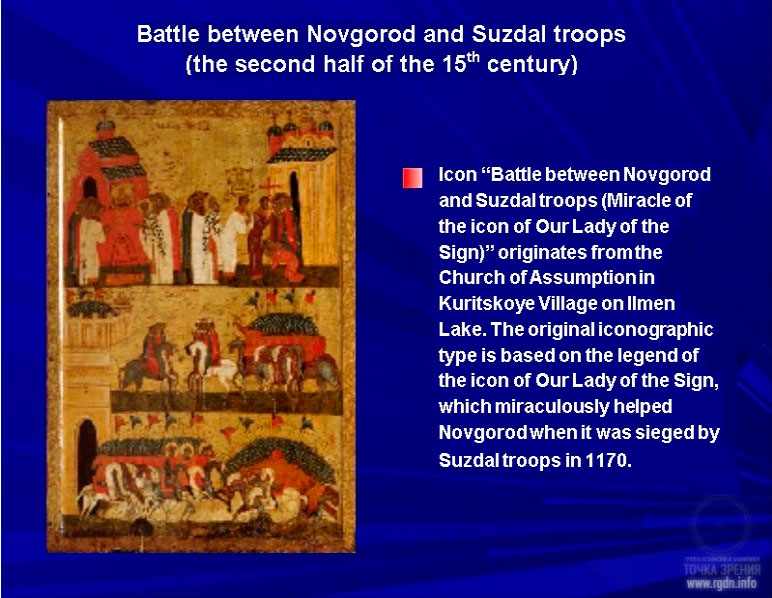
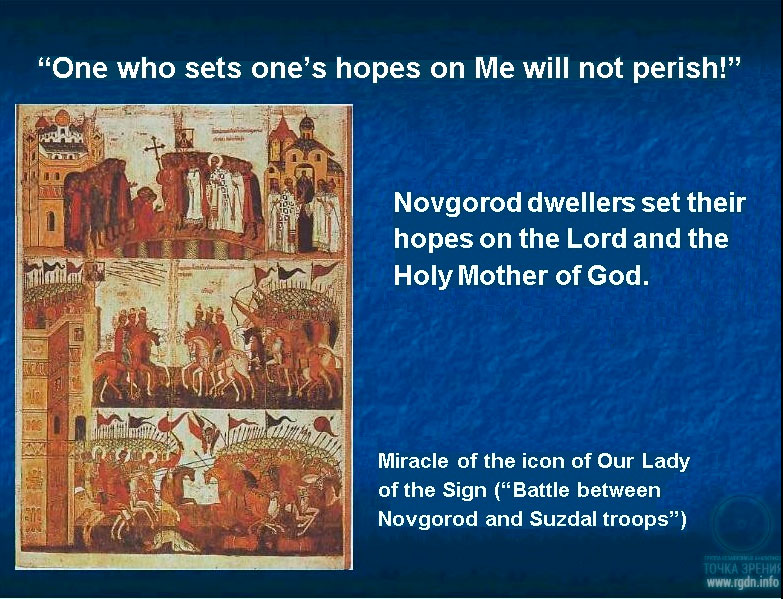
As mentioned above, “the icon feast started to be celebrated on 27 November even before the icon manifested its miracle for Novgorod inhabitants, which happened on 25 February 1169 (1170).” Why the dates are so different is described in the AllatRa book (page 537 of the book online version – allatra.us):
“... It’s a nice icon… I have already said that in ancient Rus the image of the Mother of God was the most revered among people. This icon is called Znameniye (Sign) only among the Slavs of Russia, Ukraine and Belarus (and also among those peoples who were later united into one big country), and nowhere else. In other countries it is called Our Lady (the Theotokos) Great Panagia, Pantanassa, Platytera. Few people know that in the old Slavic language the word znameniye (знаменье) is derived from the old Russian word znamya (знамя) which means a “sign”. For the first time such an icon appeared in Rus in the 11th century. But already after the earthly life of Agapit of Pechersk the Unmercenary Physician, people started to call this icon not just “znameniye”, but also “implementation”, the sign of salvation. This is the whole point!
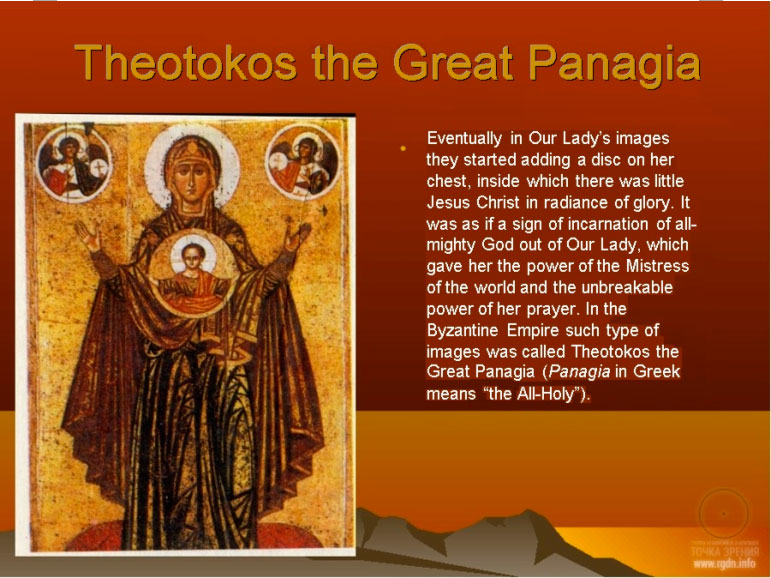

Icon of the Theotokos “More Spacious than the Heavens” (Platytera), 15th century, Greece

Icon of the Theotokos “the Queen of All” (Pantanassa), 15-16th centuries, Greece
Anastasia: To this day we can find references to it. Yet, unfortunately, church legends started to emphasise physical salvation of people rather than spiritual one. Nevertheless, if one thoroughly studies the history of those years, then even indirect references eventually lead to historical events related to certain dates. For example, on 25 February 1169, owing to the Orans (Oranta) icon, a miraculous completion of the battle at Veliky Novgorod took place, because of which later on people themselves began to revere the Mother of God as their patroness. However, those in power introduced a feast in honour of that event on 27 November according to the Julian calendar (10 December by the Gregorian calendar).
Rigden: That did happen. Simply, this event took place in the days of the Great Lent. It was in a way a bit inconvenient for them to celebrate it because of the lent. So they adjusted it to 27 November to suit the name day of the Novgorod governor of that time. Well, nothing has ever changed in power. But the most important thing is that people do feel the truth. Although for justice’s sake I should say this icon worked a lot of spiritual miracles in Kievan Rus since the 11th century. In later times many covert and overt miracles happened thanks to this icon, too. It became so popular in the entire Orthodox region that people started to depict it not only in church wall paintings. The sign became generally accessible to people. It was popularised through the copper casting of amulets, quadrifolium icons, encolpions (relics that were hung on the chest, which was called “lono” or “persi” in old days), minting of small icons, and so on.”
For two centuries the icon was kept in its “native” wooden church on Ilyina Street. However, in the mid 14th century fire occurred therein, and the icon worked one more miracle. Fire abated right after the church service in the place where the icon was exhibited. Thereafter a new stone church was built near the fire site and got the status of Znameniye Monastery. Thus the icon gained a new home. After the icon restauration in the 16th century another bigger fire took place in Novgorod and spread to several streets. City inhabitants were unable to tame the terrible disaster, and so metropolitan Makary addressed the Holy Mother of God in a prayer and conducted a procession along the VolkhovRiver bank with the famous icon in his hands. Suddenly a strong wind started, and fire stopped.
In 1611 the Swedes attacked Novgorod, cruelly killing city dwellers, ravaging houses and churches, taking away sacred items, and defacing icons. There is a record that several foreigners came to the aforesaid church on Ilyina Street when the church service was held. Once they stepped at the church threshold an invisible force threw them back. All their further attempts to enter the church had no success. Knowing that, the enemies didn’t approach the church anymore, whereas Novgorod dwellers could save themselves inside it. During the October Revolution of 1917 the icon was transferred to Novgorod City Museum, during the 2nd World War it was evacuated, and after the war it was returned to the museum. In the end, in 1991 Novgorod Eparchy won back the right to keep the wonder-working icon of Our Lady of the Sign, and it was moved to St. Sophia’s Cathedral. The icon transfer was accompanied by a miraculous celestial phenomenon – a rainbow over the cathedral dome.
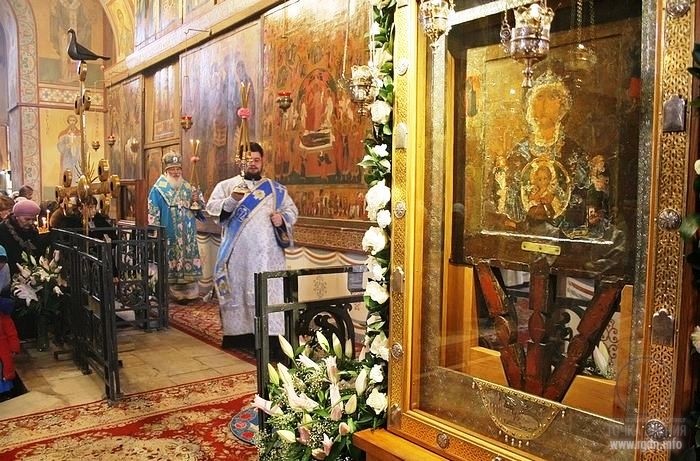
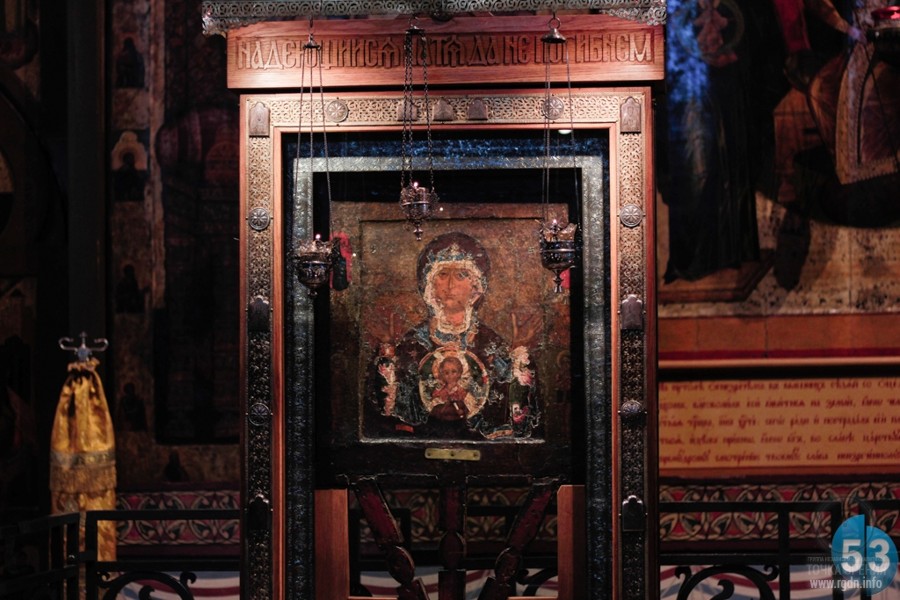
The history of icon painting knows several copies made on the basis of the icon of Our Lady of the Sign, kept both in Russia and in other countries. Names of those icons correspond to the places they are kept: Abalak, Kursk, Vologda, Pavlovsk, Solovki, Tsarskoye Selo, etc.
“The original icon of Our Lady of Abalak has not been preserved until today, but in the 17th century many copies of it were made which manifested wonder-working capacity. The most frequently attended icon copy is the one kept in ZnameniyeChurch of Abalak Monastery (AbalakVillage, Tobolsk District, Tyumen Region). The list of about 130 healings, composed in the 17th century, is still increased by modern records made by the church attendants. The most frequent cases of healings are those of children’s locomotive system disorders. The icon helps to cure leg problems in children and adults. There is a record of how a 3-year-old boy was unable to walk despite long-lasting physical therapy and treatment by several doctors, whereas his parents’ prayers to Our Lady of Abalak caused a miracle: all of a sudden the child started feeling his feet and rapidly moving on his own.
The icon has repeatedly helped to eliminate infertility. Women who had failed to become pregnant for a long time gave birth to children after the prayers performed near the icon. At that, the icon helped not just when women prayed themselves, but after prayers of their relatives or friends as well.
Furthermore, there have been numerous cases of deliverance from blindness and other eye disorders both in the old times and nowadays. The icon helps to overcome unrecoverable eye diseases, including congenital and severe acute ones.”
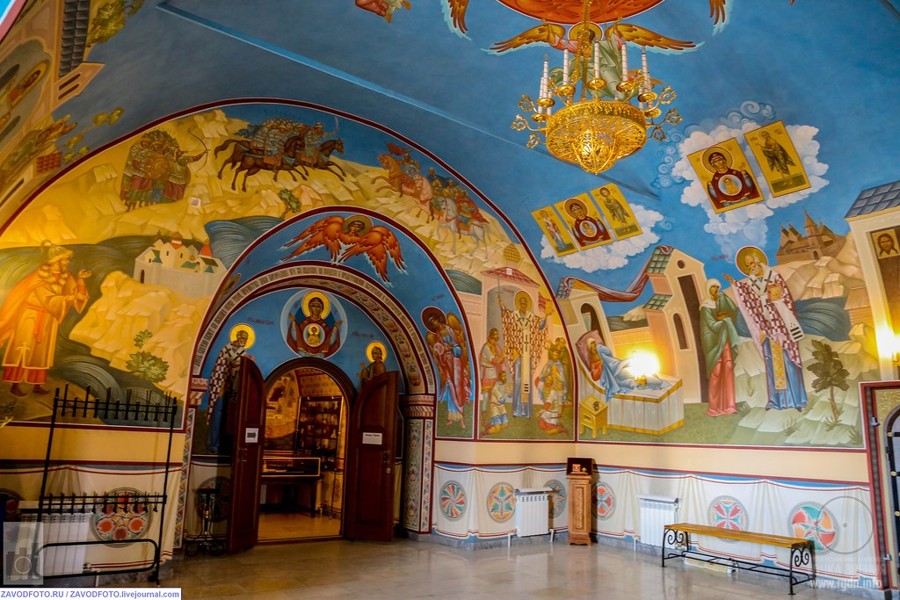
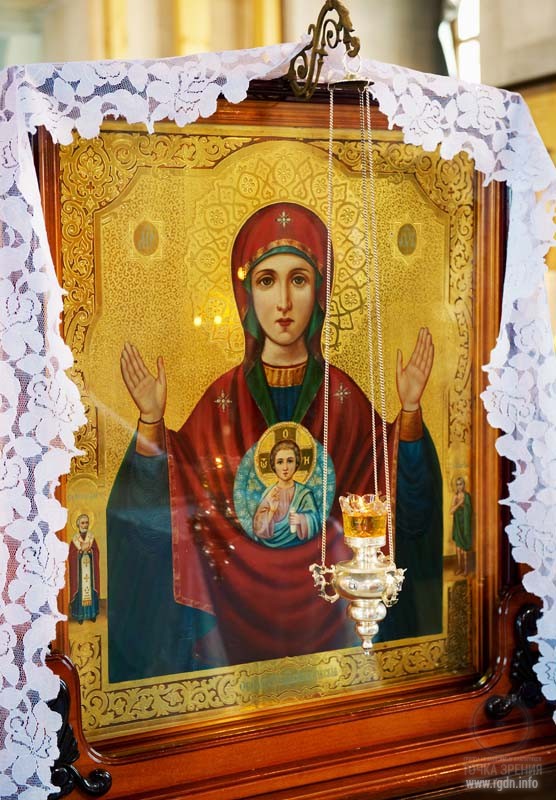
“On the tenth year Saint Prokhor fell severely ill. In a night dream Our Lady appeared to him and promised to heal him. Soon a religious procession passed through the yard of Moshniny’s residence, carrying the icon of Our Lady of the Sign (the Kursk Root icon). Prokhor’s mother took him out to touch the icon, thereafter he quickly recovered.”
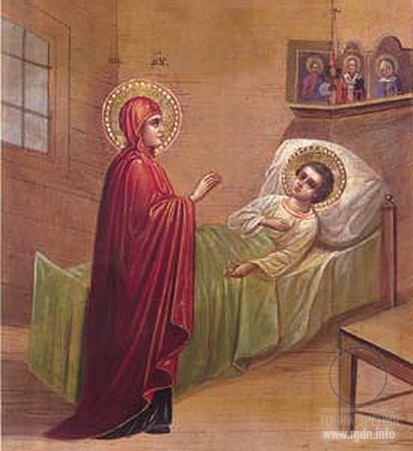
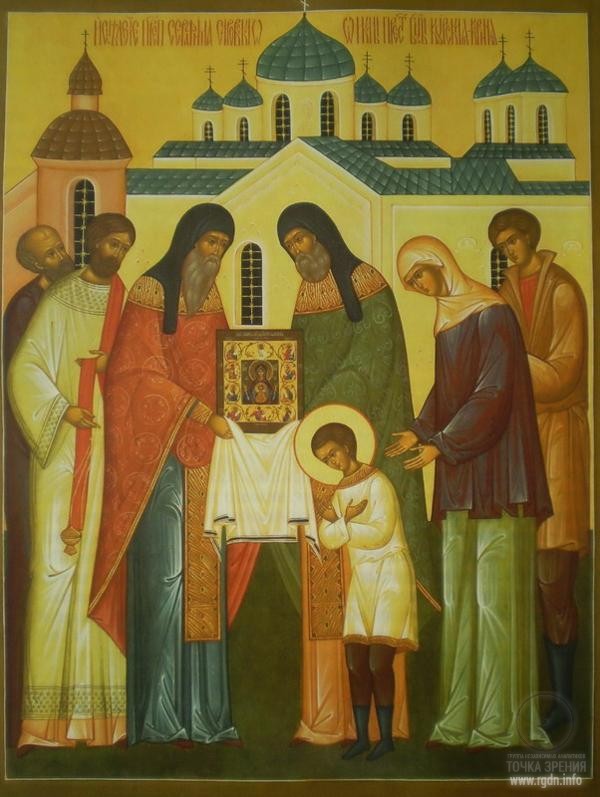
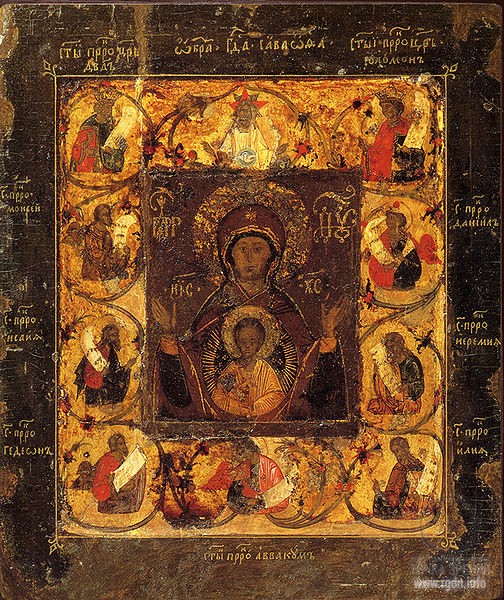
“Between 1747 and 1831 the icon of Our Lady of Tsarskoye Selo was kept over Tsar’s Gate. Only once (on 12 May 1812) it was removed and taken away. On that day there was fire in Catherine’s Palace, which threatened adjacent buildings and the Church of Our Lady of the Sign. They say, once the icon of Our Lady of Tsarskoye Selo was taken out of the church and placed facing the fire, Emperor Alexander I exclaimed: “Mother of God, save my home!” The wind that had directed fire towards the church and adjacent buildings immediately changed its direction as if obeying an invisible power, and the fire rapidly stopped.
In 1831 cholera spread all over Russia, including St. Petersburg. Residents of Tsarskoye Selo gathered near the icon of Our Lady of the Sign, placed it in the middle of the church and performed a solemn public prayer in front of it. Then they carried the icon of Our Lady around the city, singing and praying, and the whole city with its palaces turned out to be inside the circle circumscribed by the procession. As a result, Tsarskoye Selo totally evaded cholera.
History preserves numerous miraculous events and healings that took place after prayers to the icon of Our Lady of Tsarskoye Selo.”
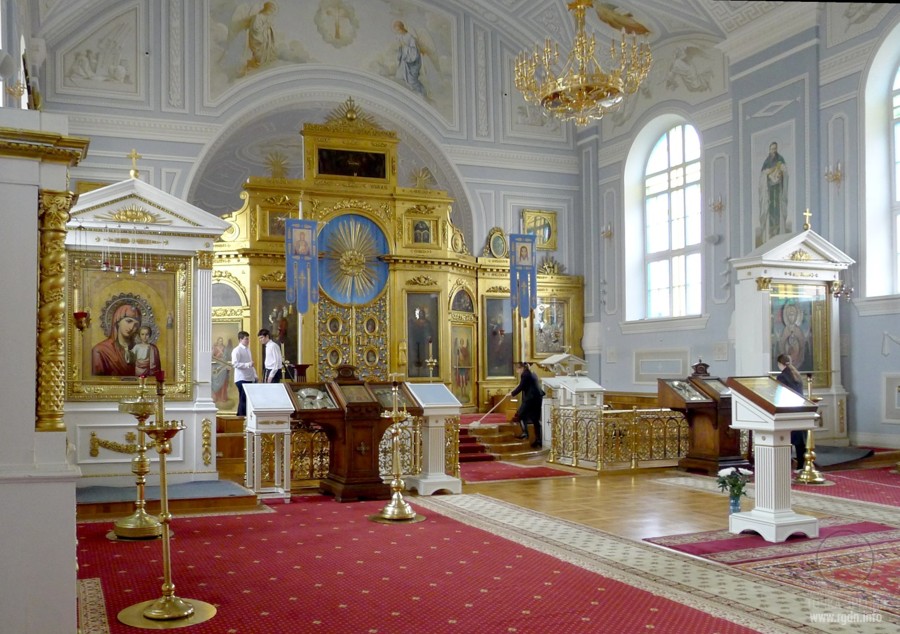
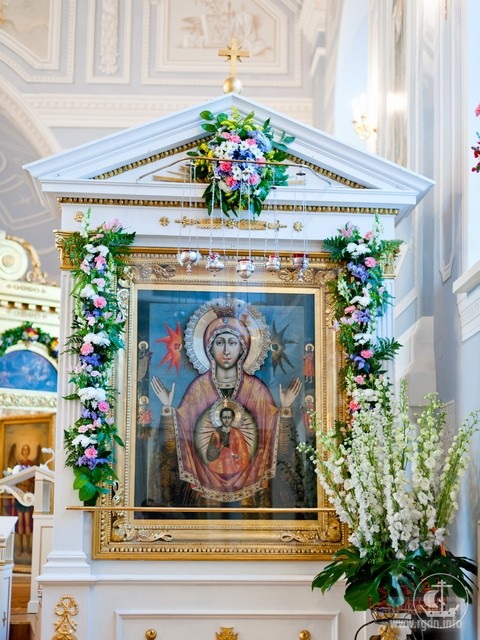
“The icon was brought to the Amur region in 1665 by Elder Ermogen from Cyrene Troitskiy Monastery. The Albazin fortress was repeatedly attacked by the Chinese, and every time the invisible veil of the Mother of God protected Albazin inhabitants against brutal enemies. However, the local garrison was too small, and so in August 1690 the fortress was abandoned.
During the Boxer Rebellion in China in 1900 the wave of mutiny reached the Russian border. Chinese troops unexpectedly appeared near Blagoveshchensk. For 19 days the enemy stood nearby and threatened to invade the Russian side. Religious service was held in the local Annunciation Cathedral uninterruptedly, and acathisti were read in front of the wonder-working icon of Our Lady of Albazin. The enemy would not dare to cross Amur and eventually moved away.”
This icon is the great sacred item of the Amur region and entire Far East!
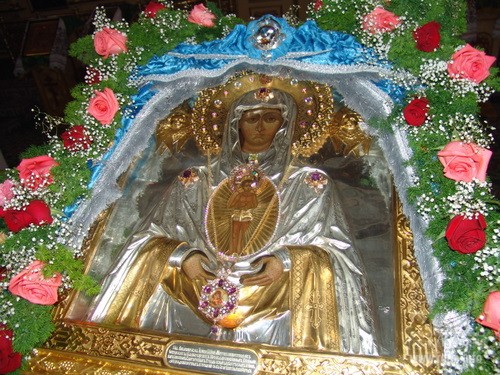
“On 14 May 1885 at 9 p.m. sisters who were praying in a monastic cell of the main monastery building noticed that the icon of Our Lady of the Sign started lightening, and Our Lady’s upward-looking gaze redirected onto the praying sisters. Virgin Mary was obviously looking straight into the sisters’ eyes. The phenomenon lasted for about 15 minutes and then repeated itself at midnight. The icon was moved to the nunnery church where miracles continued, including healings of sick people. Having heard about that, dwellers of neighbouring villages hurried to the nunnery to revere the icon and get cured. Healings took place before the eyes of many eyewitnesses. The Mother of God manifestly helped sick people, especially those who were blind or unable to walk. Many people rushed to the nunnery, seeking recovery. The icon became famous all over the region.”

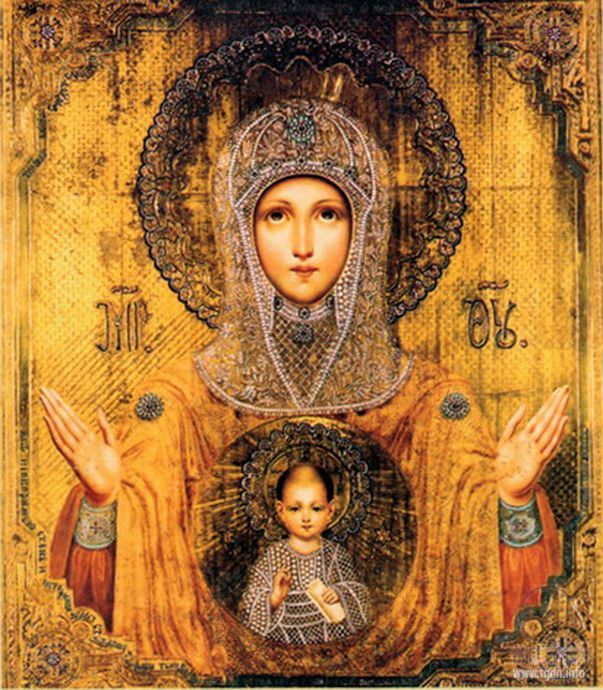
On 30 September 2009, Soyuz TMA-16 transport spacecraft delivered the revered icon of Our Lady of the Sign (Znameniye) on board of the International Space Station. The icon was flying in space for 12 days and returned to the earth with the ISS Expedition 19 on 11 October 2009. While the icon was in orbit (in the Russian segment of the ISS) it revolved around the earth 176 times.
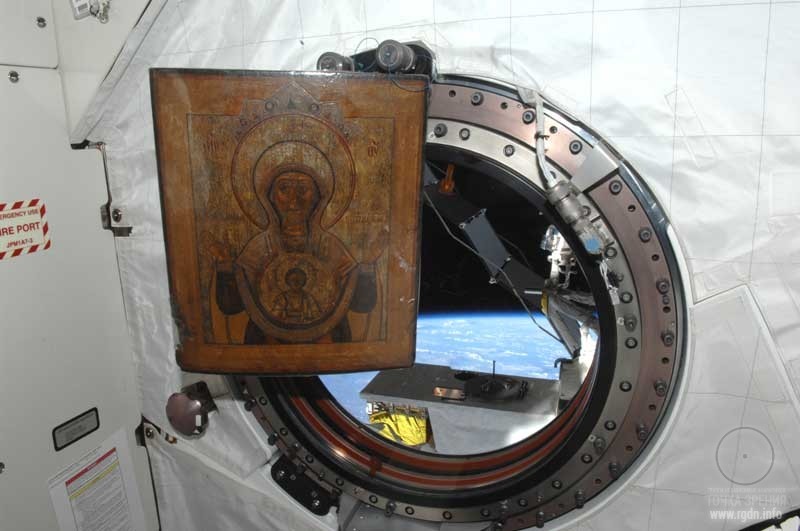
Znameniye was not the only icon to attend space. Fractions of relics of several saints were in orbit as well.
Since we’ve touched upon space, in the end of the article I would like to digress from the main subject a little and cite extracts from an interview with cosmonaut Alexey Leonov, the first person who walked in outer space.

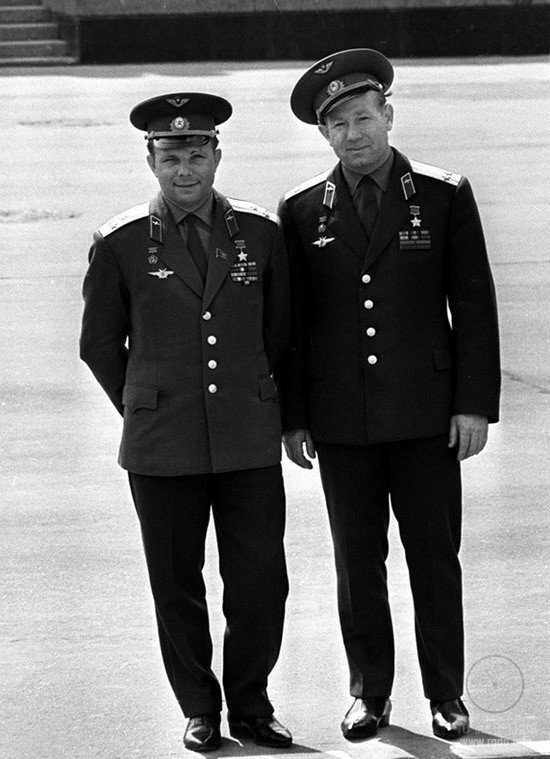
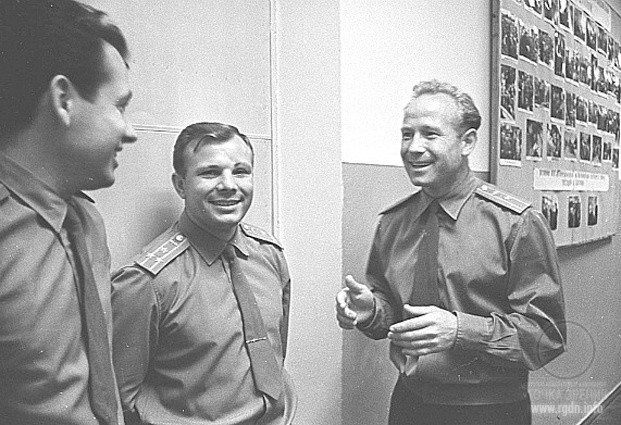
“I recall the following occurrence. On one of reception ceremonies in the Georgian Hall, dedicated to Yuri Gagarin’s flight, Khrushchev asked Yuri whether he had seen God in space. Seeing that Khrushchev was joking, Gagarin suddenly answered: “I saw.” Khrushchev turned serious and said: “Don’t tell anyone.”
***
“As a matter of fact, in my opinion Yuri was a nearly saint person. He loved his parents so much, especially his mother! He wrote very sweet letters to her. I cannot forget one of them: “I love you so much, mum, I always remember you! I loved kissing veins on your hands…” Yuri loved everyone, and everyone loved him. He took care of his family, friends and totally unfamiliar people who addressed him for help! All this evidences he had a truly Christian soul.»
***
“Alexey Arkhipovich, in March 1965 you became the first earthman to walk in outer space, being one on one with the cosmic chasm. Which thoughts did you have at that moment?”
“A space flight is a real shock that shakes up the entire human being, first and foremost his or her soul. I talked to many cosmonauts. All of them recall the time spent in orbit with admiration. I remember Yuri’s words: “Having flown round the Earth on Vostok spacecraft, I have seen how beautiful our blue planet is. People, let’s preserve and augment the beauty of the Earth, not destroy it.”Later on, no matter how many times different cosmonauts flew to space, all of them had one and the same thought: “We need to preserve the Earth and its divine beauty.” Please note this is not the opinion of arts and humanities experts, but the words of engineering folks.
When I stepped out of the spacecraft in 1965, I suddenly thought: “A human being is a grain of sand, but the intellect of such “grains” has let me walk amongst the stars.” It was a truly divine view. The stars were everywhere – above and below, whereas beneath my feet the Earth floated. At that, I couldn’t throw off a thought that the atmosphere above the Earth was just as thin as… tracing paper. What do we actually do when we destroy this atmosphere and the whole Earth along with it!
Such impressions change people. When we, cosmonauts and astronauts, gather together, we don’t divide each other into “white” and “coloured”, Russians, Americans or Europeans. All of us are children of the Earth and God’s children. Without spaceflights it would be more difficult for us to grasp such a simple truth.”
This is a remarkable example of UNITY between people from various parts of the planet. An unrealistic idea persistently comes to my mind: “It would be nice to send all 7 billion earthmen to space. Perhaps, seeing their native planet from above, these 7 billion would have understood the simple truth…”
Sources used:
http://fb.ru/article/269660/ikona-znamenie-presvyatoy-bogoroditsyi-v-chem-pomogaet-chudesa-svyazannyie-s-ikonoy#image1435658
http://aksakovo.prihod.ru/news/guid/1120460
http://foma.ru/aleksej-leonov-ikonyi-v-kosmose.html
Prepared by Igor
 Mary’s Sign. Part I
votes:
398
Mary’s Sign. Part I
votes:
398
|

Project Aim










Leave comment